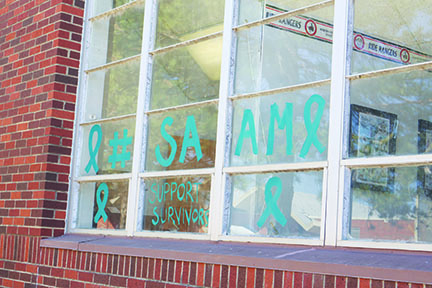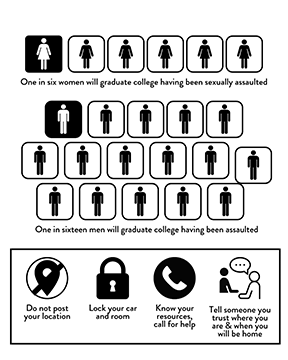By SARAH BRASHEARS
Features Editor

Sexual assault is any form of sexual violence or abuse, through physical violence, between a preparator and victim.
This crime can result in up to ten years in prison, as well as a lasting impact on the victim and the victims family. According to the National Sexual Assault Resource Center, 1 in 5 women and 1 in 16 men will graduate college having been sexually assaulted. Sexual assault is a serious crime that no victim, man or woman, ever asks for.
Statistically speaking, over 40% of college students will experience some form of sexual harassment before graduating. Of that percentile, 34.4% of women between the ages of 18 and 24 will be sexually assaulted, according to the National Sexual Assault Resource Center. However, these statistics are pulled from surveys and case files from the assaults that are reported.
More than 90% of sexual assault cases, especially those in college students, go unreported. Victims may not come forward for a number of reasons, including fear, shame or lack of trust in the system.
A study held through the United States Department of Justice revealed that many students do not come forth because they did not have proof that the incident occurred.
Sufficient evidence includes biological evidence such as fingerprints or semen, impression evidence like shoes prints, or trace evidence including hair fibers. This evidence can be hard to accumulate if one does not go to the doctor immediately after the incident occurs.
In only about 15% of sexual assault cases is evidence found to determine the perpetrator guilty. For this reason, most do not report to the law due to lack of hope in justice.
In 2015, a college student went to a party with her sister.
There, she became intoxicated and blacked out. In the midst of her blackout, she was assaulted. Her rapist pleaded not guilty, taking them to trial. During her case, the rapist hired many investigators, attorneys and expert witnesses to support his case.
Miller spoke of this in her victim-report, which can be listened to through 60 minutes overtime, saying, “…. were going to find details about my personal life to use against me, loopholes in my story to invalidate me and my sister in order to show that this sexual assault was in fact a misunderstanding.” She also mentions that her rapist does not know her, but she knows him as the man who was inside her, changing her life.
Victim-blaming remains a prominent problem with most sexual assault cases. Cases, such as Miller’s, use events and evidence to prove non-verbal consent, loopholes in evidence, and personal lives to validate the assault. Other common forms of victim-blaming can look like questioning what the girl was wearing or why she was out so late. This is in an attempt to suggest that the victim’s clothing choices or activities contributed to the assault. Other cases will use the consumption of alcohol or drugs to brush off the assaulters actions, claiming that the victim does not remember the
See AWARENESS, Page 9
Stay alert, stay aware
event as it happened, as they were intoxicated. Regardless, no means no and intoxication is not consent. Thus, many victims are afraid to come forward out of fear and shame that the assault was their fault.
In the hours following an assault, victims are flooded with emotions. These include shock and disbelief, numbness, guilt, anger, and fear. According to the Pennsylvania Psychiatric Institute, post traumatic stress disorder is one of the most common and longest lasting consequences of a sexual assault. Survivors relive the moment through intrusive memories and flashbacks, often resulting in fear of a social life. Many survivors will withdraw from normal life, cut communication with those closest to them, and begin to develop habits of not eating or sleeping. The consequences for assault to not just remain with the assaulter. However, the victim never asked for the consequences they live with for the rest of their lives.
Staying safe on campus remains NWOSU’s priority for all students. To protect yourself, it is important to know your resources, stay alert, avoid posting your location at any time on social media, think about a plan B if you are going out, tell someone you trust where you are and who you are with, and be secure.
When you are traveling anywhere, whether on campus or around town, be aware of your surroundings. Consider asking a friend to go with you. If you travel alone, only wear a headphone in one ear, helping you hear your surroundings and stay aware of the environment.
Many social media sites, such as snapchat, use your location. Consider disabling this function and review all other location sharing sites on your phone. Also be aware of what you are posting. Consider posting a place after you have left, or post images that make it difficult to decipher where you are.
When leaving, consider a plan B for any potential-sticky situations. Memorize a safe person’s phone number in case your phone dies. Carry emergency cash in case your card will not work. Carry a spare key, keep your car filled with gas, and put jumper cables in your trunk. When leaving alone or to a new place, tell someone where you are going. Also include who you will be with and around in case they can not get a hold of you. It is also important to give them an estimated time of when you will be home, as well as message them you are home safely, in case something happens while you are out.
It is always smart to remain secure. Always lock your doors and windows, whether you are traveling or in for the night. If the dorm’s main door is propped open, be sure to let the resident on duty know. Never leave anything unlocked, in order to prevent a break in to your room or vehicle.
NWOSU has many emergency contacts. To find these specific numbers, you can visit www.nwosu.edu/campus-safety. Save these numbers in your phone, where you can quickly access them if needed. When in doubt, always call 911 for an emergency. NWOSU also has a free counselor on staff if you feel the need to talk to someone about a situation. You can find Taylor Wilson’s information at www.nwosu.edu/student-services/counseling.
No sexual assault case is the same. No sexual assault case is justifyable. If you, or someone you know, has been sexually assaulted please use your resources to help. 1 in 6 women and 1 in 16 men are sexually assaulted before graduation. No is not consent, and yes while intoxicated is not consent.

